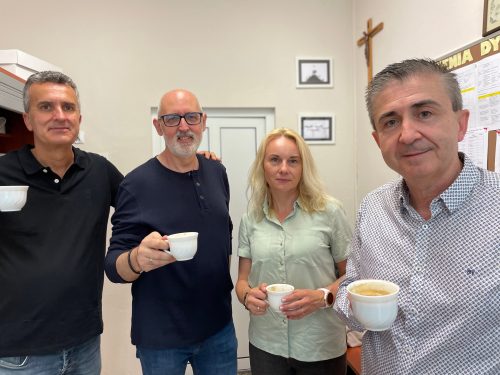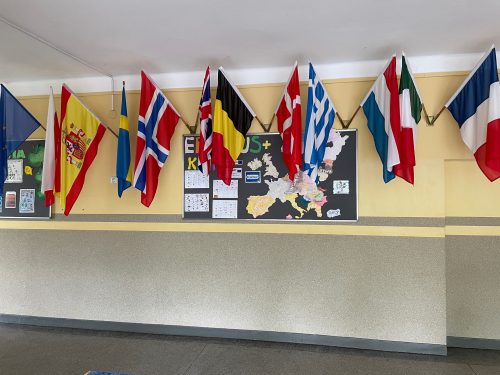ERASMUS+ CURSO 2023/24 – POLONIA.

ERASMUS + KA1 project (Accreditation granted for 2024-28)
From 20th to 24th May 2024 (Monday to Friday) we have been more than delighted to do some shadowing job of Chemistry, English, Music (medieval Polish folk music) and Spanish lessons in Szkola podstawowa nr 15 im Polskich Noblistow, a neighbouring area of Czestochowa in southern Poland.
Sylwia Cyran was our contact as the leading Erasmus coordinator in the Polish school, with whom we have held a long-standing relationship for more than ten years now with what used to be called Comenius and later turned into Erasmus under the umbrella of European Union funding.
Czestochowa is about 200 kms from Krakow. The school is located in a residential area 8 kms from the town centre. This school has experienced unprecedented refurbishment since we first visited them back in 2009, with an impressive investment in isolation (physical conditions) and digitalization (educational conditions) which are two key parameters to facilitate learning conditions. Digital boards date back to 2020, which means they are in good shape; the software with which they are equipped is efficient and fast. Notwithstanding, wifi signal is really weak around the school without signal repeaters, which means they largely depend on ethernet cable across classrooms. The school is not equipped with trolleys of laptops for students, but even if they were available the work conditions for students wouldn’t be the best because of the fact that the Wi-Fi signal is so weak and unsteady. Smartphones are strictly prohibited within the school, which means that teachers mostly resort to digital or paper-based resources, as well as a relevant reliance on textbooks, which is also a reality in Spain.
Their teachers’ room looks in good shape, with all work documents tidily and systematically displayed to teachers and school premises that would parallel Spanish standards in a way. The Czestochowan school will be visiting ours early mid-October 2024, again with five students that will exchange homes and experiences.
About the statistics of the school this could be said to be a small one with only 171 students, 87 girls and 84 boys, 50, 8% female and 49,2% male. Their teaching ages include levels that would correspond to Primary and Compulsory Secondary Education in Spain, ages 7 to 15, ending in 8th grade of compulsory secondary education before Polish students move to another school, either professional or academic, to do another 4-5 years of schooling until they join University at the age of 19-20 depending on the school mainstream they may have followed. The vast majority of the teaching staff is female, with only three positions for male staff: the headteacher, one of the PE teachers and a religion teacher who is also a priest.
Compared to 15 years ago, when our teaching staff visited this school for the first time, we must say they have progressed dramatically in such a manner that digitally and in terms of classroom equipment this Polish school is as cutting-edge as ours as an example of how a shift in the educational leadership, headteacher figure since 2011, of a school more often than not brings about a revolution in teaching methods. The decoration of classrooms is simply admirable. Students’ behaviour is best possible, and this surely sets an example of how schools in countries like Spain (Andalusia in our case) still have a long way to go in terms of investment and collaborative work among teachers.
The fact that all teachers open their doors to the visiting Spanish team and that all teachers welcome us and students observe best discipline standards without prior notice is another example of how the unity of an educational team makes it possible for a school to turn it into what is always expected: an educational ethos that favours right educational levels, especially if we take into account that the ratio of Polish classrooms in Secondary Education is 24-25, which means and average of 5 students less that in IES Huarte de San Juan (Linares).
The languages taught in the Polish school are, in this order, English, German and Spanish. French is for some reason not considered worth learning as for historical reasons Germans have been neighbours, apart from the fact that sociologically the emigration rates of Poland to Germany are massive, which turns this foreign language into a life skill that lets them join the labour market; pretty much the same happens with English, with hundreds of Polish living and working in the UK, especially before the Brexit came into place. Spanish has its presence secured in this school because the Erasmus Coordinator, Sylwia Cyran has been in a liaison with Spanish schools in Bailén and Motril, now in Linares, which makes sense for Spanish to have a place in this school, also given that fact Spanish is a lingua franca spoken in most South American countries as well as a language for trade and travel worldwide.
Lessons are 45 minutes each, with a break of 10 minutes between the first and second period and then breaks of 15 minutes between lessons, which totals 40 minutes of break and lessons. Lunch is served at school, it features strictly water and a main course and is at 12.30, lunch time is 12.30 to 13.00, with a fifth period before students leave for school at 14.00, also because lessons are started as early as 8.00. This all contrasts with the thick Spanish timetable at school, with periods of 60 minutes nonstop and with only one break of 30 minutes between periods 3 and 4, which means people are kept sitting for as long as 3 hours in a row each time, this might have an impact on their attention span. Perhaps, if the length of lessons were shortened as in Poland and students were allowed to move and stand on their feet more regularly we might cut down on the amount of conflict and lack of focus in our lessons in Spain.













